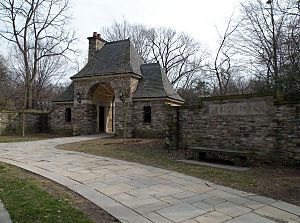Frick Park facts for kids
Quick facts for kids Frick Park |
|
|---|---|

Reynolds St. Entrance
|
|
| Type | Municipal Park |
| Location | Pittsburgh, Pennsylvania |
| Area | 644 acres (1.006 sq mi) |
| Created | 1919 |
| Operated by | City of Pittsburgh Citiparks, Pittsburgh Parks Conservancy |
| Website | www.pittsburghparks.org/frick |
Frick Park is the biggest park in Pittsburgh, Pennsylvania. It covers about 644 acres, which is like 490 football fields! It's one of Pittsburgh's four main historic parks.
The park started thanks to Henry Clay Frick. When he passed away in 1919, he left 151 acres of land for the park. This land was near his home, which is now part of The Frick Pittsburgh. He also set up a special fund of $2 million (which would be about $35 million today!) to help take care of the park for a long time. The park officially opened on June 25, 1927. Henry Clay Frick had promised his daughter, Helen Clay Frick, that he would create a park, and he kept his word.
Henry Clay Frick's son, Childs Frick, loved animals and nature because he spent so much time in the woods and valleys of the park. Childs Frick later became a famous American vertebrate paleontologist. This means he studied the bones of animals that lived long ago, like dinosaurs! He also became a big supporter and leader at the American Museum of Natural History.
Over the years, Frick Park has grown from its original size. It now stretches from Point Breeze to Squirrel Hill and even reaches the border of Edgewood. Pittsburgh is a city known for its industries, but Frick Park is one of the few places that still has untouched steep valleys and old forests. It's like a nature reserve where you can find many native plants and lots of wildlife. You might see owls, wild turkeys, foxes, and many other animals living there.
Contents
Frick Environmental Center
The first Frick Environmental Center was built in 1979. It was a place where people could learn about the environment and take part in nature programs. Sadly, a fire in 2002 made the building unusable. It was taken down, and a new center began to be built in late 2014.
The new Frick Environmental Center opened in 2016. It's a large building, about 15,500 square feet, and cost $16 million to build. The center has classrooms both inside and outside, public restrooms, and other useful areas. It's designed to be very energy-efficient and "green." For example, it uses solar panels to make electricity and a geothermal system to heat and cool the building. In 2017, it received a very high environmental certification called LEED Platinum. The Pittsburgh Parks Conservancy helps run the center along with the City of Pittsburgh.
Park Ecology and Restoration
The eastern edge of Frick Park is next to Nine Mile Run. This stream used to be very polluted. But between 2003 and 2006, a big effort was made to clean it up and bring it back to health. Because of this, Frick Park now stretches almost all the way to the Monongahela River.
From 2017 to 2018, people worked to remove about 2.6 acres of bush honeysuckle. This plant is an invasive plant, which means it's not native to the area and can take over, harming other plants. It had been a problem in the park for about 20 years. After the honeysuckle was cleared, a wonderful discovery was made: ten healthy butternut trees! This was very important because almost all other butternut trees in the park are sick with a fungal disease called butternut canker, which can kill them.
Fun Things to Do in the Park
Frick Park has many fun things for visitors to enjoy. There's a popular playground known as the Blue Slide playground, and a special area for dogs called a dog park. Every year, there's a Shakespeare in the Park show in the upper part of the park, where you can watch plays by William Shakespeare.
When it snows, sledding down a hill near Beechwood Boulevard and Nicholson Street is a favorite winter activity for many local families. The hill is long and sloped, ending near some trees. There are different paths to go down, and sometimes sledders might bump into each other. To help keep everyone safe, the city put up "no sledding" signs in 2010.
Images for kids


